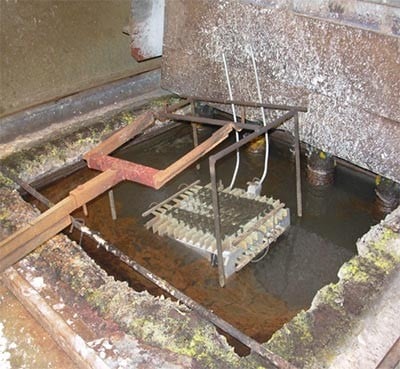钎焊产生固体热接头和机械接头,用于制造散热器、液体冷板、热交换器和底盘。
什么是钎焊?
钎焊是在另外两块金属之间熔化金属以将它们连接起来的过程。在热管理领域,该工艺的常见金属包括铜和铜基合金、铝硅基合金和镍合金。这个过程使我们能够创建钎焊翅片散热器,并扩展我们的热管理技术工具箱。
钎焊不要与炖煮混淆,炖煮是一个烹饪过程,您首先在高温下烤肉,然后在锅等密闭容器中用一定量的液体缓慢烹饪。无论如何,钎焊金属更像是高温烘烤。
如果应用得当,钎焊会产生紧密的接头,因为该过程依赖于毛细管作用,使零件之间的钎焊材料芯吸。钎焊材料是一种合金,其熔化温度低于您连接在一起的零件。更坚固、更一致的接头采用与配合部件紧密匹配的材料制成。在所有钎焊工艺中,配合部件都固定在一起,以确保它们在钎焊过程中保持彼此的几何关系。一旦零件冷却,它们要么准备就绪,要么需要一些精加工,例如去除残留的助焊剂或最终的矫直或加工。
钎焊和焊接有什么区别?
对于那些想知道的人来说,钎焊听起来像焊接一样可怕。钎焊本质上是焊接,只是在更高的温度(高于 450°C 或 840°F)下。更高的温度为更多的材料选择打开了大门,其中包括我们最喜欢的材料之一,铝。这两种工艺都使用填充材料(如焊料)将金属件连接在一起。如果金属和大气需要,还会在混合物中添加助焊剂以防止接头氧化。
在精灵中,钎焊翅片散热器是指钎焊和焊接组件。有时我们只焊接铜散热器,但我们希望将这些散热器作为吉尼用户可用选项的一部分。
钎焊钎焊鳍片散热器:粘合鳍片的更老、更强壮的兄弟姐妹
钎焊翅片散热器在几何形状上与粘合钎焊散热片几乎相同。与粘合鳍片一样,钎焊钎焊片散热器由底座、鳍片和钎焊材料组成,用于将零件连接在一起。底座通常具有紧密的凹槽,供钎焊材料芯吸。钎焊翅片散热器的另一个好处是接头更坚固,底座和翅片之间的界面阻力更小。

选择您的工艺:不同类型的钎焊
虽然它们有多种类型的钎焊,但我们将介绍热管理中使用的常见钎焊。
可控气氛钎焊

Controlled Atmosphere Brazing (CAB) is conducted in an oven with a specific mixture of air surrounding the parts. This mixture is primarily inert gasses and not oxygen that can oxidize the joints. Since the parts are placed in an oven, the braze material flows horizontally outwards where it’s not pulled by capillary action. This process is great for making a brazed fin heat sink since the base grooves are ideal in wicking the braze material.
真空钎焊
顾名思义,真空钎焊是在真空室中进行的。这是为了去除任何可能氧化钎焊接头的氧气或其他可能被夹在接头微小口袋中的气体。在实践中,真空钎焊比其他类型的钎焊具有优势,因为它不需要助焊剂来防止氧化。这使得真空钎焊在热交换器和液体冷板等复杂组件中很受欢迎,因为它们很难清除任何残留的助焊剂。

用盐浴助焊剂浸渍钎焊
现在,浸渍钎焊很棒。您将钎焊材料放在接头和夹具之间,就像真空钎焊或 CAB 组件一样。然后你把这个组件放在一个不锈钢夹具上。用看起来像一个巨大的叉子的升降机,你可以把整个东西放成熔盐。熔盐的热量通过铝组件传导并回流所有钎焊材料。由于它是浸没式的,因此不需要通量,回流焊可以向多个方向扩散,而不仅仅是水平扩散。

Torch Brazing
在某些情况下,我们将使用割炬钎焊来制作棘手的原型、概念验证或复杂的小批量生产。火炬钎焊利用气体火焰熔化被连接的两个金属部件之间的填充材料。由于这通常是一个手动过程,因此保留用于少量。由于我们没有使用铝钎焊所需的严格控制气氛,因此此过程通常保留用于铜和镍合金钎焊。
总而言之
在构建高质量或高复杂性的热管理产品时,钎焊为我们提供了大量选择。吉尼在技术选择页面提供铜和铝钎焊翅片散热器。
Are you looking help designing or manufacturing a Brazed Assembly? We can help with either your brazed heat sinks, heat exchangers, or liquid cold plates. Contact Us today for assistance!






